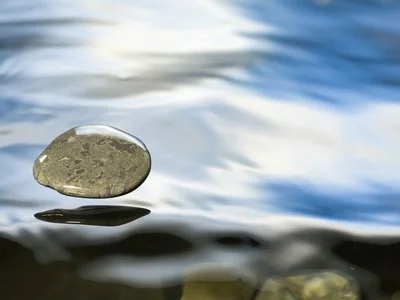There's a place down by the river where the bank is wide and sandy. It overlooks a low-lying rock dam over which the river spills. Behind that dam, the water is flat and calm -- perfect for skipping stones across.
My son stops here every time we come by on walks or bike rides. He scrambles down to the water's edge, scavenges for flat stones just the right size to fit between his palm and forefinger. This is where he learned to skip stones.
I started skipping stones as a toddler beside a reservoir in Montana. My family spent many weekends camped along its shore. As soon as I grew bored watching the folks fish, which didn't take long, I took to skipping stones -- well away from the anglers, of course. I threw for hours.
Mastery of the art didn't come easy, I am sure. My son struggled through many unsuccessful attempts to imitate my slicing sidearm motion. His stones always fell into the water with a thud, making a single splash, until one day -- quite without warning -- he sent one skimming across the river one, two, three and four skips. He's been skipping without coaching or instruction ever since.
Finding the right stone is the real trick to successful stone skipping. It needs to be heavy enough to carry well, but also small enough to fit comfortably in yourhand. It should be flat, with rounded edges, the kind that most often lie along the banks of rivers. Locating a good supply beside a lake, far from moving water, can be difficult.
You wedge the stone along its edges between your forefinger and thumb, lean over to the side, and fling the stone sidearm while letting go of the thumb first to encourage a fast spinning motion. The stone should fly from your hand horizontal to the water and barely skim across the surface as gravity gradually brings it down.
A French physicist, Lydéric Bocquet, reduced the skipping action of the spinning stone to a mathematical formula. His equations showed that the faster it is travelling, the more times it will bounce. To bounce at least once without sinking, the stone needs to be travelling at a minimum speed of about 1 kilometer per hour.
The spin is critical, because it keeps the stone fairly flat from one bounce to the next. It also has a gyroscopic effect, preventing the stone from tipping and falling sideways into the water.
To match the world record of 38 bounces -- set by Jerdone Coleman-McGhee on the Blanco River in Texas in 1992 -- Bocquet calculates that a stone 10 centimeters wide would have to be travelling at about 40 kilometers per hour and spinning at 14 revolutions a second.
My son and I are not throwing for any records, but we do keep count of the bounces and with each successive throw we try to match or better our day's best. Sometimes it's just the beauty of the motion that captivates, or the thrill of seeing the stone arc through space.
I've heard that the Inuits of Alaska skim rocks across icefields and that Bedouin tribesmen of Arabia do the same thing on sand. In Scotland, the World Stone Skimming Championships is held each September on the island of Easdale, famous for its slate deposits and the millions of flat water rounded pebbles on its beaches.
There must be something powerfully primal about an activity that compels young boys to forego video games and grown men to set aside their ambitions to engage in a sport without prey or pay. Our genetic memories keep bringing us back to these shores where we've played for millennia. The same stone, perhaps, that flew from the fist of a pre-Columbian child is pulled from up from the earth by this 21st century youngster, wedged between his fingers and flung back out into space, skimming one, two, three, four and five (!) times across the surface before sinking back down into the depths of time.


